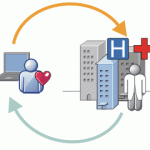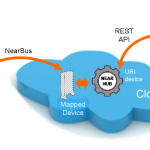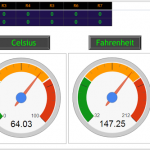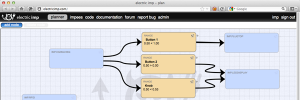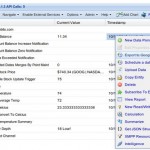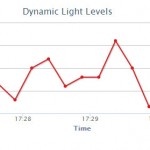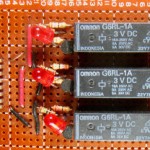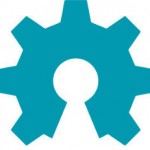Although we have recently been focusing on the systems and hardware that can be used in various Internet-of-things applications, there’s much more to learn and understand. One particular aspect is the way in which devices send and receive data between themselves and servers – and an example of that is MQTT.
Message Queue Telemetry Transport, or MQTT, is an open protocol for machine-to-machine (M2M) communications that enables the transfer of telemetry-style data in the form of messages from a network of distributed devices to and from a small message “broker” server – whilst maintaining usefulness over high-latency, expensive or bandwidth-constrained networks. This publish/subscribe messaging transport protocol is designed to overcome the challenges of connecting the rapidly expanding physical world of sensors and actuators as well as personal computers and mobile devices.

The origin of MQTT goes back to the late 1990s, where co-inventor Andy Stanford-Clark of IBM became immersed in M2M communication whilst working with industry partners to mine sensor data from offshore oil platforms, to inform better preventative and predictive maintenance. One of those industry partners was Arlen Nipper of Arcom, an expert in embedded systems for oilfield equipment. Together, Stanford-Clark and Nipper wrote the initial version of MQTT in 1998, and their open-source messaging software has continued to be improved over the following years.
Until recently, one of the challenges limiting widespread development of IoT technologies has been the lack of a clearly accepted open standard for message communication with embedded systems. Today, however, MQTT looks set to play an increasingly significant role in facilitating the Internet-of-Things. In much the same way that the HTTP standard paved the way for the widespread adoption of the World Wide Web as a tool for the sharing of people-to-people information on the Internet, MQTT could set the stage for the machine-to-machine equivalent of the WWW.
MQTT is particularly well matched with networks of small, distributed, lightweight, and pervasive devices – not just mobile phones and personal computers, but embedded computers, sensors and actuators – which can make up the “Internet of Things”. The MQTT protocol specification enables a publish/subscribe messaging model in a very lightweight way, useful for connections with remote devices where a small code footprint is required – low-cost 8-bit micro controllers, for example – and/or where network bandwidth is at a premium.
There is also another standard for sensors – MQTT-S, for which this specification is aimed at embedded devices on non-TCP/IP networks, such as ZigBee/802.15.4 wireless sensor mesh networks. MQTT-S is an extension of the MQTT protocol aimed at wireless sensor networks, extending the MQTT protocol beyond TCP/IP infrastructures for non-TCP/IP sensor and actuator networks. Furthermore, MQTT is already widely supported by servers and brokers including IoT implementations such as cosm, Thingspeak, nimbits, and more.
MQTT is already used in a wide variety of embedded systems. An example documented by IBM demonstrates a pacemaker that communicates via RF telemetry to an MQTT device in the home of a patient – allowing nightly data uploads to the hospital for analysis. This allows recovering patients to leave hospital earlier to recover at home whilst still being monitored by medical professionals. Or if an unexpected event occurs, the system can immediately alert the hospital and emergency services without any patient interaction.
Furthermore IBM has recently announced its’ new “MessageSight appliance”, designed to handle heavy-duty real-time sharing of large amounts of data between sensors and devices and using the MQTT protocol to do so. Finally, IBM and Eurotech have bought MQTT to the open standards process of OASIS – the Organisation for the Advancement of Structured Information Standards. OASIS is a non-profit international consortium that drives the development, convergence and adoption of open standards for the global information society.
The OASIS standardisation process started in March 2013, with the goal of establishing MQTT as an open, simple and lightweight standard protocol for M2M telemetry data communication. The newly established OASIS MQTT Technical Committee is producing a standard for the MQTT Protocol – together with requirements for enhancements, documented usage examples, best practices, and guidance for use of MQTT topics with commonly available registry and discovery mechanisms.
Although MQTT does seem to be championed by IBM, the OASIS recently called for industry representatives earlier this year to sponsor the formation of its MQTT Technical Committee, and was answered by Cisco, the Eclipse Foundation, Eurotech, IBM, Machine-To-Machine Intelligence, Red Hat, Software AG and TIBCO. The group will take the MQTT 3.1 specification, donated to the committee by IBM and Eurotech where it was originally developed, and work to standardise and promote its adoption it as an open standard.
In defining MQTT standards and making them open for all, this allows its’ use and will hopefully guarantee a future standard allowing interaction with devices from all suppliers and manufacturers who choose to work with it. It’s a standard that holds a lot of promise for the future of an efficient and affordable Internet-of-things.
At the LX Group we have a wealth of experience and expertise in the IoT field, and can work with the MQTT standard, hardware and software to solve your problems. Our goal is to find and implement the best system for our customers, and this is where the LX Group can partner with you for your success.
We can create or tailor just about anything from a wireless temperature sensor to a complete Internet-enabled system for you – within your required time-frame and your budget. For more information or a confidential discussion about your ideas and how we can help bring them to life – click here to contact us, or telephone 1800 810 124.
LX is an award-winning electronics design company based in Sydney, Australia. LX services include full turnkey design, electronics, hardware, software and firmware design. LX specialises in embedded systems and wireless technologies design. https://lx-group.com.au
Published by LX Pty Ltd for itself and the LX Group of companies, including LX Design House, LX Solutions and LX Consulting, LX Innovations.

